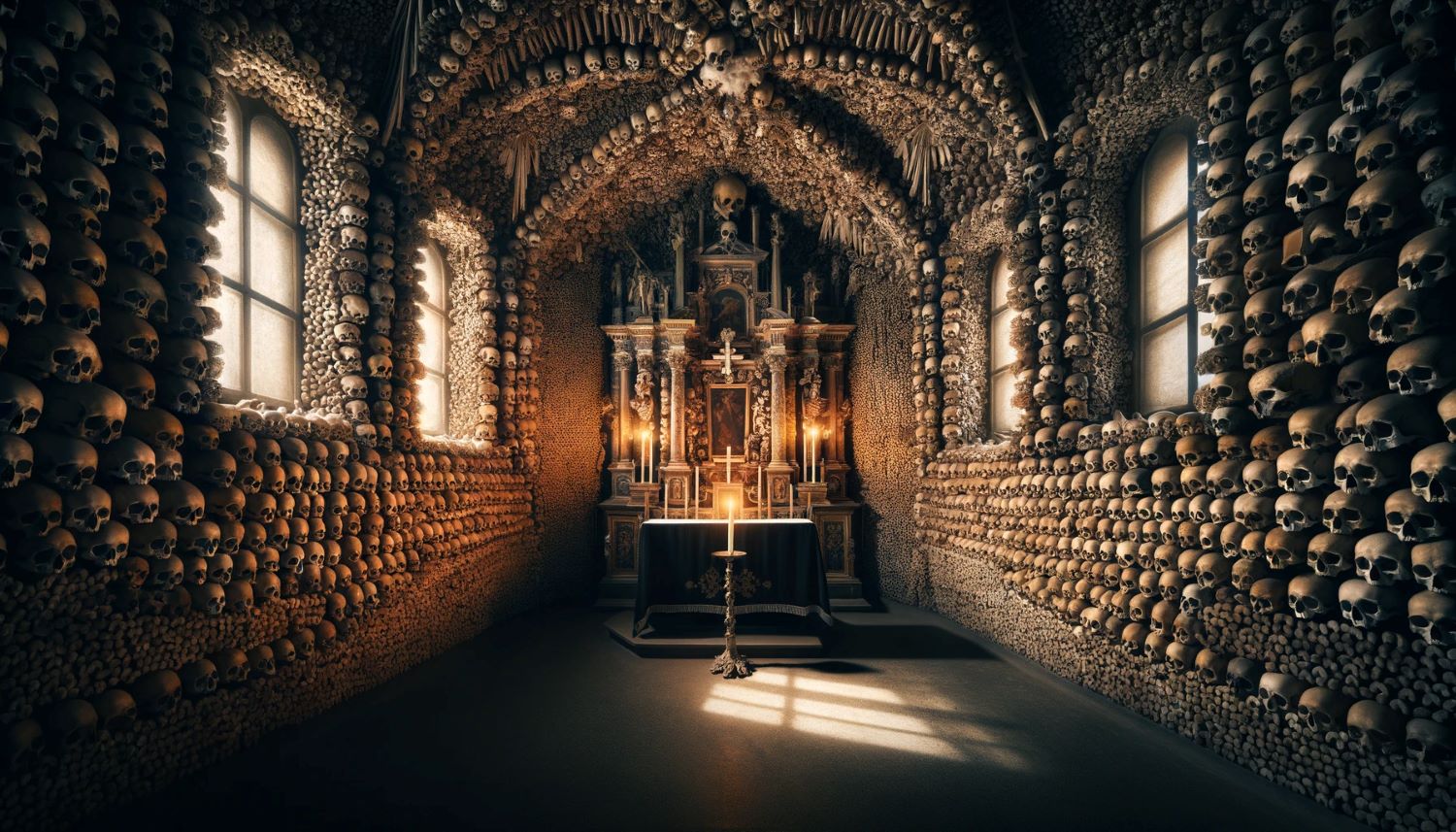Home>Arts and Culture>Why Is There A Chapel In A Hospital


Arts and Culture
Why Is There A Chapel In A Hospital
Published: March 4, 2024
Ericka Andersen, an editor at Christian.net, expertly merges digital strategy with content creation, focusing on faith and societal issues. Her communication skills enhance the platform's engaging narratives, fostering meaningful dialogue on belief's impact on society.
Discover the significance of having a chapel in a hospital and its impact on arts and culture. Explore the intersection of spirituality and healing in healthcare settings.
(Many of the links in this article redirect to a specific reviewed product. Your purchase of these products through affiliate links helps to generate commission for Christian.net, at no extra cost. Learn more)
Table of Contents
The Historical Significance of Hospital Chapels
The presence of hospital chapels can be traced back to ancient times when hospitals were closely associated with religious institutions. In the early days, hospitals were often run by religious orders, and the provision of spiritual care was considered an integral part of the healing process. The chapel served as a place for prayer, reflection, and solace for both patients and caregivers. It was believed that spiritual well-being was closely linked to physical health, and the chapel provided a space for individuals to seek comfort and strength during times of illness and distress. Over the centuries, the tradition of having a chapel within a hospital has endured, evolving to accommodate the diverse spiritual needs of patients and their families.
-
Symbol of Compassion and Care: Hospital chapels have historically been a symbol of the compassionate care provided by religious orders and later by healthcare institutions. The presence of a chapel within a hospital conveyed the message that healing was not just about treating physical ailments but also about addressing the spiritual and emotional needs of individuals.
-
Connection to Healing Traditions: The historical significance of hospital chapels is deeply rooted in the healing traditions of various cultures and faiths. In many ancient healing practices, spirituality was considered essential for achieving overall well-being. The chapel served as a space where individuals could draw upon their faith and find strength to cope with illness and suffering.
-
Legacy of Holistic Care: The historical significance of hospital chapels also reflects the legacy of holistic care in healthcare. Throughout history, healers and caregivers recognized the interconnectedness of the body, mind, and spirit. The chapel was a tangible representation of this holistic approach to healing, offering a place for individuals to seek spiritual support alongside medical treatment.
-
Continued Relevance in Modern Healthcare: Despite the advancements in medical science and the secularization of healthcare, the historical significance of hospital chapels remains relevant in modern times. The chapel continues to serve as a reminder of the enduring connection between spirituality and health, offering a space for individuals of all faiths and beliefs to find comfort and peace during challenging times.
In summary, the historical significance of hospital chapels is deeply intertwined with the traditions of compassionate care, holistic healing, and the recognition of the spiritual dimension of health. The presence of a chapel within a hospital reflects a commitment to addressing the diverse needs of patients and their families, honoring the historical legacy of spiritual care in healthcare settings.
Read more: Why Was The Chapel Bridge Built
The Role of Spirituality in Healing
Spirituality plays a crucial role in the healing process, encompassing the interconnectedness of the mind, body, and spirit. Here are some key aspects of the role of spirituality in healing:
-
Promoting Emotional Well-being: Spirituality provides individuals with a sense of purpose, hope, and inner peace, which can significantly impact their emotional well-being during times of illness. It offers a source of comfort and resilience, enabling individuals to cope with the challenges of their health conditions.
-
Fostering Resilience and Coping: For many people, spirituality serves as a foundation for resilience and coping. It provides a framework for understanding and making sense of suffering, allowing individuals to find meaning in their experiences and navigate through difficult circumstances with greater strength and fortitude.
-
Enhancing Quality of Life: Studies have shown that spiritual well-being is associated with improved quality of life among patients facing serious illnesses. Engaging in spiritual practices, such as prayer, meditation, or religious rituals, can contribute to a greater sense of well-being and overall satisfaction with life.
-
Supporting End-of-Life Care: Spirituality plays a significant role in end-of-life care, offering comfort and solace to individuals as they approach the final stages of their lives. It provides a framework for addressing existential concerns, facilitating a sense of closure, and supporting the dying process with dignity and peace.
-
Complementing Medical Treatment: While spirituality is not a substitute for medical treatment, it can complement the healing process by addressing the holistic needs of individuals. Integrating spiritual care with medical care can contribute to a more comprehensive approach to healing, recognizing the multifaceted nature of well-being.
In essence, spirituality serves as a vital component of holistic healing, acknowledging the profound impact of faith, meaning, and connection on the well-being of individuals. By recognizing the role of spirituality in healing, healthcare institutions can better support the diverse needs of patients and foster a more inclusive approach to care.
Providing a Space for Reflection and Solace
Hospital chapels serve as sanctuaries within healthcare settings, offering individuals a dedicated space for quiet reflection, contemplation, and finding solace amidst the challenges of illness. Here's a closer look at the significance of providing such a space within hospitals:
-
Quiet Retreat: Hospital chapels provide a tranquil environment away from the clinical settings, where patients, families, and healthcare staff can retreat for moments of peace and introspection. The serene atmosphere of the chapel allows individuals to temporarily escape the stress and anxiety often associated with medical environments, creating a space for inner calm and reflection.
-
Opportunity for Spiritual Connection: The chapel serves as a place where individuals can connect with their spiritual beliefs, engage in prayer or meditation, and seek comfort in their faith. Regardless of religious affiliation, the chapel offers a neutral ground for individuals to draw upon their spiritual resources and find strength in their beliefs, fostering a sense of connection and hope.
-
Emotional Support: In times of distress, the chapel provides a safe haven for individuals to express their emotions, process their feelings, and seek solace. Whether facing a personal health crisis or grappling with the illness of a loved one, the chapel offers a supportive environment where individuals can find emotional release and gather their thoughts in moments of uncertainty.
-
Cultural and Religious Inclusivity: Hospital chapels are designed to accommodate the diverse cultural and religious backgrounds of patients and their families. They often feature elements that are inclusive of various faith traditions, such as symbols, sacred texts, and artwork, creating a welcoming space that respects and honors different beliefs.
-
Encouraging Healing Conversations: The chapel can also serve as a venue for meaningful conversations and support among patients, families, and healthcare providers. It provides a setting where individuals can engage in discussions about life, illness, and spirituality, fostering a sense of community and understanding within the healthcare environment.
In essence, hospital chapels play a vital role in providing a space for reflection and solace, acknowledging the holistic needs of individuals beyond their medical conditions. By offering a sanctuary for spiritual connection, emotional support, and cultural inclusivity, the chapel contributes to the overall well-being of patients, families, and healthcare staff within the hospital setting.
Supporting Patients and Families in Times of Crisis
During times of crisis, such as serious illness, medical emergencies, or end-of-life care, hospital chapels play a crucial role in supporting patients and their families. Here's how these sacred spaces provide essential support during challenging circumstances:
-
Emotional Comfort: Hospital chapels offer a refuge where patients and families can seek emotional comfort and solace. In moments of crisis, individuals often experience heightened levels of anxiety, fear, and uncertainty. The chapel provides a serene environment where they can find a sense of peace, express their emotions, and gather their thoughts amidst the turmoil of the situation.
-
Spiritual Guidance: For many individuals, crises prompt a deep need for spiritual guidance and support. Hospital chapels cater to this need by providing a space for prayer, meditation, and spiritual contemplation. Regardless of religious affiliation, the chapel serves as a place where individuals can draw upon their faith and find strength in their spiritual beliefs, fostering a sense of connection and hope during challenging times.
-
Family Support: Hospital chapels also serve as spaces where families can come together for mutual support and reflection. When a loved one is facing a health crisis, family members often experience their own emotional and spiritual struggles. The chapel offers a setting where they can gather, share their concerns, and find comfort in each other's presence, fostering a sense of unity and resilience within the family unit.
-
Crisis Counseling: In some instances, hospital chapels may provide access to chaplains or spiritual care providers who offer crisis counseling and support. These trained professionals can offer a listening ear, spiritual guidance, and compassionate presence to individuals and families navigating through the complexities of a health crisis. Their presence in the chapel enhances the level of support available to those in need.
-
Rituals and Ceremonies: Hospital chapels accommodate the diverse cultural and religious needs of patients and families by providing a space for rituals, ceremonies, and religious observances. Whether it involves a prayer service, a blessing, or a cultural tradition, the chapel allows individuals to engage in meaningful practices that hold significance during times of crisis, offering a sense of comfort and continuity in the face of adversity.
In summary, hospital chapels serve as invaluable resources for supporting patients and families during times of crisis. By providing emotional comfort, spiritual guidance, family support, crisis counseling, and space for rituals, these sacred spaces contribute to the holistic well-being of individuals facing challenging health circumstances.
Multi-faith Considerations in Hospital Chapel Design
In designing hospital chapels, it is essential to consider the diverse religious and spiritual needs of patients and their families. Here are the key aspects to consider in creating a multi-faith inclusive chapel design:
-
Flexibility and Adaptability: Hospital chapels should be designed with flexibility in mind to accommodate the diverse practices and rituals of different faith traditions. This may include creating spaces for prayer, meditation, or religious ceremonies that can be easily adapted to meet the specific requirements of various religious groups.
-
Inclusive Symbols and Artwork: The design of the chapel should incorporate inclusive symbols and artwork representing a variety of faith traditions. This can include elements such as sacred texts, religious symbols, and artwork that reflect the cultural and spiritual diversity of the hospital's patient population.
-
Neutral and Welcoming Environment: Hospital chapels should strive to create a neutral and welcoming environment that respects the beliefs of all individuals. The design should avoid favoring any particular religious tradition, ensuring that the space is inclusive and inviting to people of diverse faiths and backgrounds.
-
Accessibility and Privacy: Considerations should be made to ensure that the chapel is easily accessible to individuals of all abilities and that it provides spaces for private prayer and reflection. This may involve incorporating areas for individual prayer, as well as larger gathering spaces for communal worship and religious observances.
-
Cultural Sensitivity: Designing a multi-faith chapel requires a deep understanding of the cultural sensitivities and religious practices of different communities. It is important to consult with religious leaders and community representatives to ensure that the chapel design is respectful and considerate of diverse cultural and religious traditions.
-
Interfaith Dialogue and Education: The chapel design can also incorporate elements that promote interfaith dialogue and education, fostering a spirit of understanding and cooperation among individuals of different faiths. This may include informational displays, literature, and resources that provide insights into various religious traditions and promote mutual respect and appreciation.
By carefully considering these multi-faith considerations in hospital chapel design, healthcare institutions can create inclusive and supportive spaces that honor the diverse spiritual and religious needs of their patients and their families. The design of the chapel plays a significant role in promoting a sense of belonging, comfort, and spiritual well-being for individuals of all faith traditions, contributing to a more holistic approach to healthcare.















